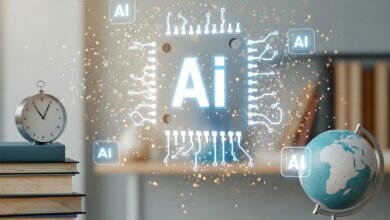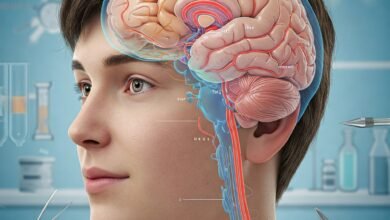Artificial Intelligence: The Double-Edged Sword of Technology

Introduction to Artificial Intelligence
Artificial Intelligence (AI) refers to the simulation of human intelligence processes by machines, particularly computer systems. These processes include learning, reasoning, problem-solving, perception, and language understanding. The evolution of AI can be traced back to the mid-20th century, with pioneering work by researchers such as Alan Turing and John McCarthy, who laid the foundational concepts that govern today’s AI technologies. Over the decades, AI has expanded significantly in scope and capability, experiencing various waves of optimism and challenges.
Today, AI is generally categorized into two main types: Narrow AI and General AI. Narrow AI, also known as weak AI, is designed to perform specific tasks, such as facial recognition, virtual assistants, or even playing games. This type of AI is prevalent in various applications, including healthcare, finance, and autonomous vehicles. On the other hand, General AI, or strong AI, refers to machines that possess the ability to understand, learn, and apply knowledge across a broad range of tasks, in a manner akin to human capabilities. While General AI remains largely theoretical, its potential implications raise profound ethical and philosophical questions.
The current applications of AI are transformative, affecting numerous sectors globally. In healthcare, AI algorithms assist in diagnostics and personalized medicine, improving patient outcomes. In the financial sector, AI systems streamline operations and enhance fraud detection. Moreover, industries like manufacturing leverage AI-driven automation to increase efficiency and reduce costs. The rapid advancements in machine learning and data analytics have accelerated AI’s growth, making it an integral component of modern technology. However, this dual-edged sword necessitates careful consideration of its social, ethical, and economic ramifications.
The Benefits of Artificial Intelligence
Artificial Intelligence (AI) has emerged as a powerful catalyst for progress across various sectors, bringing numerous advantages that enhance operational efficiency, foster innovation, and improve decision-making processes. In healthcare, for instance, AI algorithms can analyze vast datasets quickly to identify disease patterns and potential treatment pathways, leading to faster diagnosis and personalized medicine. Such advancements not only improve patient outcomes but also optimize the allocation of resources within healthcare systems.
In the finance sector, AI-driven tools analyze market trends and consumer behavior, enabling financial institutions to provide more accurate predictions and tailored services. For example, AI algorithms assist in fraud detection by swiftly identifying unusual transaction patterns, thereby mitigating potential losses and enhancing security for clients. The incorporation of AI in financial services also streamlines processes like underwriting and risk assessment, making them significantly more efficient.
The transportation industry is experiencing a profound transformation due to AI technologies as well. Autonomous vehicles, powered by advanced AI systems, promise to reduce accidents caused by human error while enhancing traffic management through real-time data analysis. Companies like Waymo and Tesla have made considerable strides in developing self-driving technology that makes transportation safer and more efficient, fundamentally changing how people travel and goods are delivered.
A critical aspect of AI’s potential lies in its capacity to solve complex problems that were previously insurmountable. For example, AI algorithms are being utilized to address climate change by optimizing energy usage and predicting environmental trends. Moreover, the ability of AI to simulate scenarios enables businesses to innovate and adapt to market demands swiftly.
Overall, the integration of AI into diverse industries showcases its transformative potential. From improving healthcare outcomes to enhancing financial services and revolutionizing transportation, AI serves as a double-edged sword that, when wielded appropriately, can significantly improve quality of life and operational efficiency.
The Risks and Challenges of Artificial Intelligence
As the implementation of artificial intelligence (AI) technologies continues to accelerate across various sectors, it brings with it a spectrum of risks and challenges that must be critically examined. One of the most pressing concerns is job displacement due to automation. Industries ranging from manufacturing to customer service are increasingly relying on AI-driven systems for efficiency, often resulting in significant reductions in the workforce. This transformation raises ethical questions regarding the responsibility of companies to their employees and the potential for socio-economic inequality as workers are left behind in an evolving job market.
Moreover, the risk of biased algorithms cannot be overlooked. AI systems are trained on datasets that may reflect existing societal prejudices, leading to outcomes that perpetuate discrimination. For example, numerous cases have arisen where facial recognition technology has shown higher error rates among certain demographic groups, which raises significant ethical concerns about fairness and accountability in AI deployment. As organizations implement AI solutions, they must prioritize transparency and equity to avoid exacerbating societal divides.
Another critical challenge lies in security concerns associated with AI technologies. The potential for cyberattacks targeting AI systems poses significant risks, as malicious actors may manipulate these technologies for harmful purposes. Furthermore, the implications of autonomous decision-making add another layer of complexity. As AI systems become increasingly capable of making decisions without human intervention, the question arises: who is responsible when these systems fail? Historical incidents, such as those involving autonomous vehicles, illustrate the urgent need for regulatory frameworks to govern AI use and ensure public safety.
In summary, while artificial intelligence holds tremendous potential to revolutionize how we live and work, it is imperative to confront the associated risks and ethical dilemmas with a proactive and nuanced approach. Case studies of AI failures and misuse illuminate the path forward, emphasizing the importance of a balanced perspective as society navigates the challenges of rapid technological advancement.
The Future of Artificial Intelligence: Balancing Innovation and Ethics
As we advance into an era dominated by artificial intelligence (AI), the need to strike a balance between innovation and ethical considerations becomes increasingly essential. The rapid pace of AI development offers immense potential for improving various aspects of society, including healthcare, transportation, and education. However, this innovation must be tempered with a commitment to ethical guidelines that ensure technology serves humanity rather than undermines its values.
To achieve this equilibrium, robust policy-making and regulation are imperative. Governments and organizations must engage in thoughtful dialogue to establish frameworks that promote AI development while addressing potential risks. This includes considering issues such as data privacy, algorithmic bias, and the implications of autonomous systems. Policies should not only focus on the benefits of AI but also prepare safeguards against its misuse. Moreover, regulatory bodies must remain adaptive to the evolving technology landscape, ensuring that regulations keep pace with rapid advancements.
Public awareness and education also play a critical role in shaping the future trajectory of artificial intelligence. As stakeholders, individuals should be equipped with knowledge about both the possibilities and challenges posed by AI technologies. This fosters informed public discourse, enabling citizens to advocate for responsible AI development that prioritizes ethical considerations alongside innovation. By cultivating a culture of awareness, we can encourage a collaborative approach to AI advancement, where diverse perspectives contribute to shaping policies that uphold human rights and social justice.
In conclusion, navigating the future of artificial intelligence requires a multidisciplinary approach that emphasizes innovation paired with ethical responsibility. By prioritizing effective regulation, informed public engagement, and collaborative policy-making, we can harness AI’s transformative power for the greater good, ensuring that it remains a double-edged sword carefully wielded in service to humanity.






















